ESP RENAULT TWINGO RS 2009 2.G Electrical Equipment - Petrol Injection Service Manual
[x] Cancel search | Manufacturer: RENAULT, Model Year: 2009, Model line: TWINGO RS, Model: RENAULT TWINGO RS 2009 2.GPages: 348
Page 139 of 348
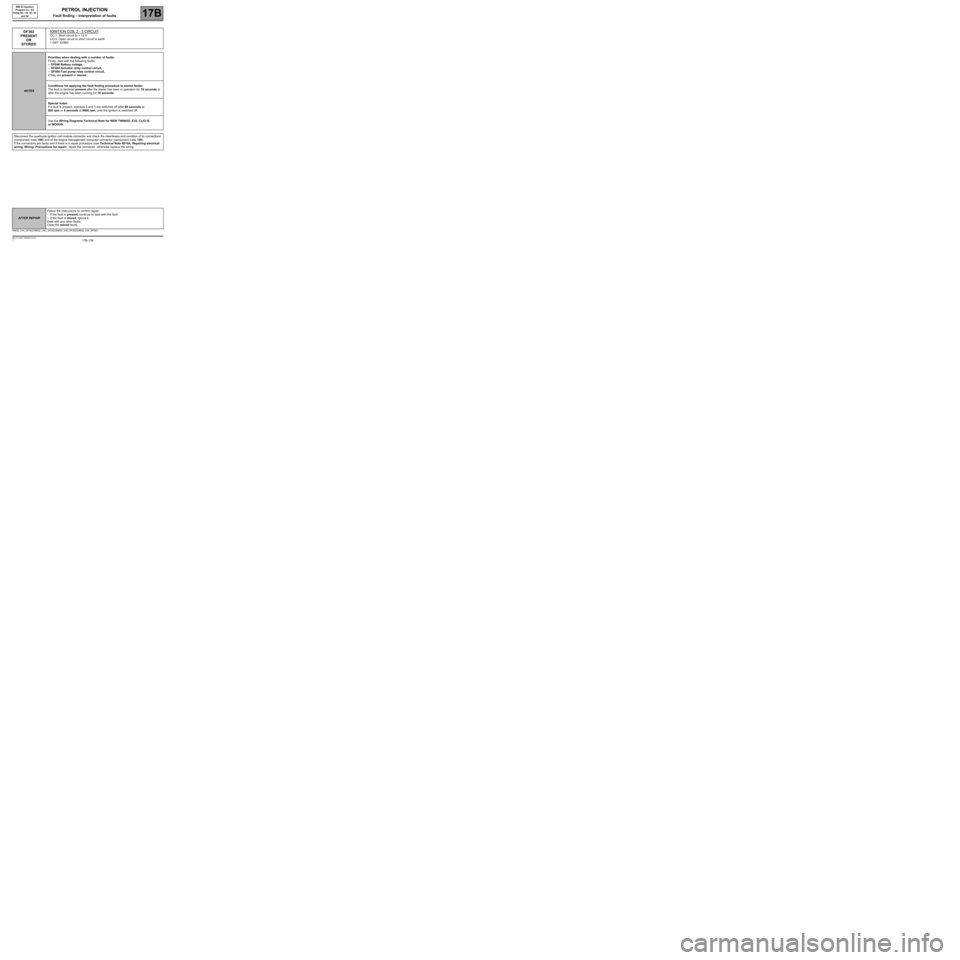
17B-139V7 MR-413-X44-17B000$133.mif
PETROL INJECTION
Fault finding – Interpretation of faults17B
SIM 32 Injection
Program no.: D3
Vdiag No.: 44, 4C, 50
and 54
DF362
PRESENT
OR
STOREDIGNITION COIL 2 - 3 CIRCUIT
CC.1: Short circuit to + 12 V
CO.0: Open circuit or short circuit to earth
1.DEF: EOBD
NOTESPriorities when dealing with a number of faults:
Firstly, deal with the following faults:
–DF046 Battery voltage,
–DF084 Actuator relay control circuit,
–DF085 Fuel pump relay control circuit,
if they are present or stored.
Conditions for applying the fault finding procedure to stored faults:
The fault is declared present after the starter has been in operation for 10 seconds or
after the engine has been running for 10 seconds.
Special notes:
If a fault is present, injectors 2 and 3 are switched off after 60 seconds at
600 rpm or 6 seconds at 6000 rpm, until the ignition is switched off.
Use the Wiring Diagrams Technical Note for NEW TWINGO, E33, CLIO III,
or MODUS.
Disconnect the quadruple ignition coil module connector and check the cleanliness and condition of its connections
(component code 108) and of the engine management computer connector (component code 120).
If the connectors are faulty and if there is a repair procedure (see Technical Note 6015A, Repairing electrical
wiring, Wiring: Precautions for repair), repair the connector, otherwise replace the wiring.
SIM32_V44_DF362/SIM32_V4C_DF362/SIM32_V50_DF362/SIM32_V54_DF362
AFTER REPAIRFollow the instructions to confirm repair:
–If the fault is present, continue to deal with the fault.
–If the fault is stored, ignore it.
Deal with any other faults.
Clear the stored faults.
Page 142 of 348
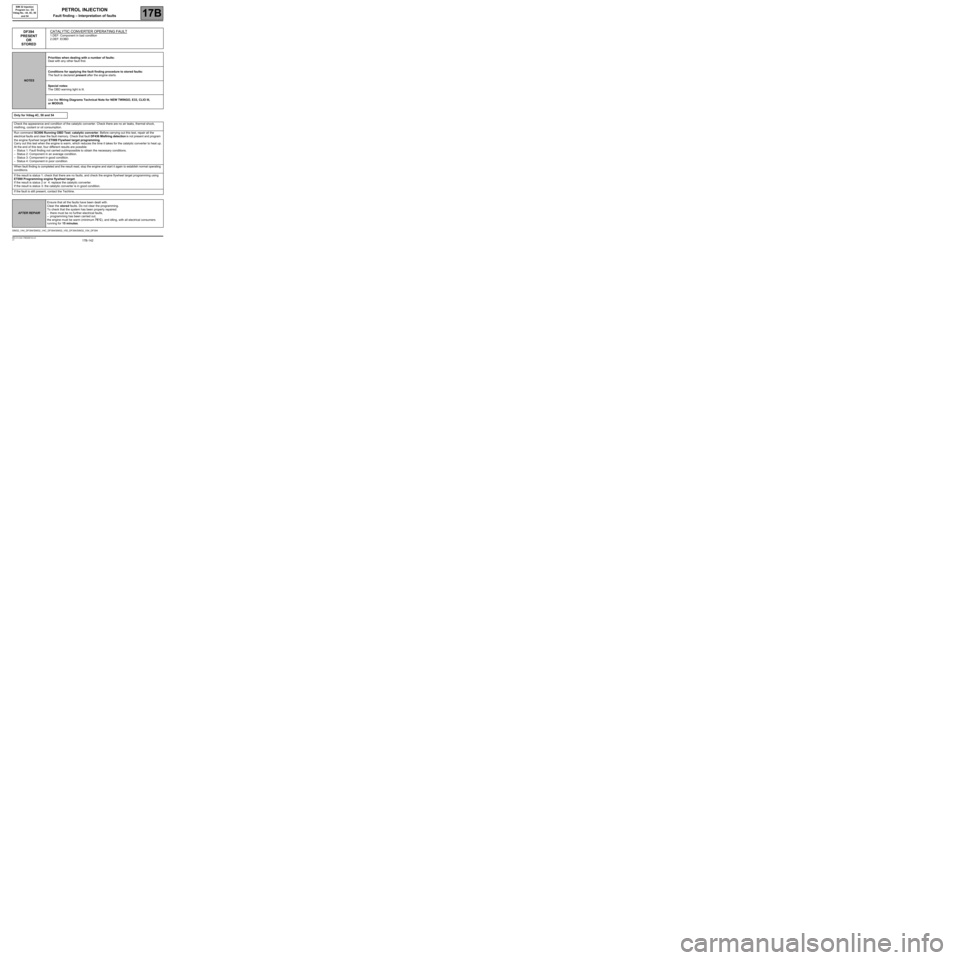
17B-142V7 MR-413-X44-17B000$133.mif
PETROL INJECTION
Fault finding – Interpretation of faults17B
SIM 32 Injection
Program no.: D3
Vdiag No.: 44, 4C, 50
and 54
DF394
PRESENT
OR
STOREDCATALYTIC CONVERTER OPERATING FAULT
1.DEF: Component in bad condition
2.DEF: EOBD
NOTESPriorities when dealing with a number of faults:
Deal with any other fault first.
Conditions for applying the fault finding procedure to stored faults:
The fault is declared present after the engine starts.
Special notes:
The OBD warning light is lit.
Use the Wiring Diagrams Technical Note for NEW TWINGO, E33, CLIO III,
or MODUS.
Only for Vdiag 4C, 50 and 54
Check the appearance and condition of the catalytic converter. Check there are no air leaks, thermal shock,
misfiring, coolant or oil consumption.
Run command SC006 Running OBD Test: catalytic converter. Before carrying out this test, repair all the
electrical faults and clear the fault memory. Check that fault DF436 Misfiring detection is not present and program
the engine flywheel target ET089 Flywheel target programming.
Carry out this test when the engine is warm, which reduces the time it takes for the catalytic converter to heat up.
At the end of this test, four different results are possible:
–Status 1: Fault finding not carried out/impossible to obtain the necessary conditions.
–Status 2: Component in an average condition.
–Status 3: Component in good condition.
–Status 4: Component in poor condition.
When fault finding is completed and the result read, stop the engine and start it again to establish normal operating
conditions.
If the result is status 1: check that there are no faults, and check the engine flywheel target programming using
ET089 Programming engine flywheel target.
If the result is status 2 or 4: replace the catalytic converter.
If the result is status 3: the catalytic converter is in good condition.
If the fault is still present, contact the Techline.
SIM32_V44_DF394/SIM32_V4C_DF394/SIM32_V50_DF394/SIM32_V54_DF394
AFTER REPAIREnsure that all the faults have been dealt with.
Clear the stored faults. Do not clear the programming.
To check that the system has been properly repaired:
–there must be no further electrical faults,
–programming has been carried out,
the engine must be warm (minimum 75˚C), and idling, with all electrical consumers
running for 15 minutes.
Page 146 of 348
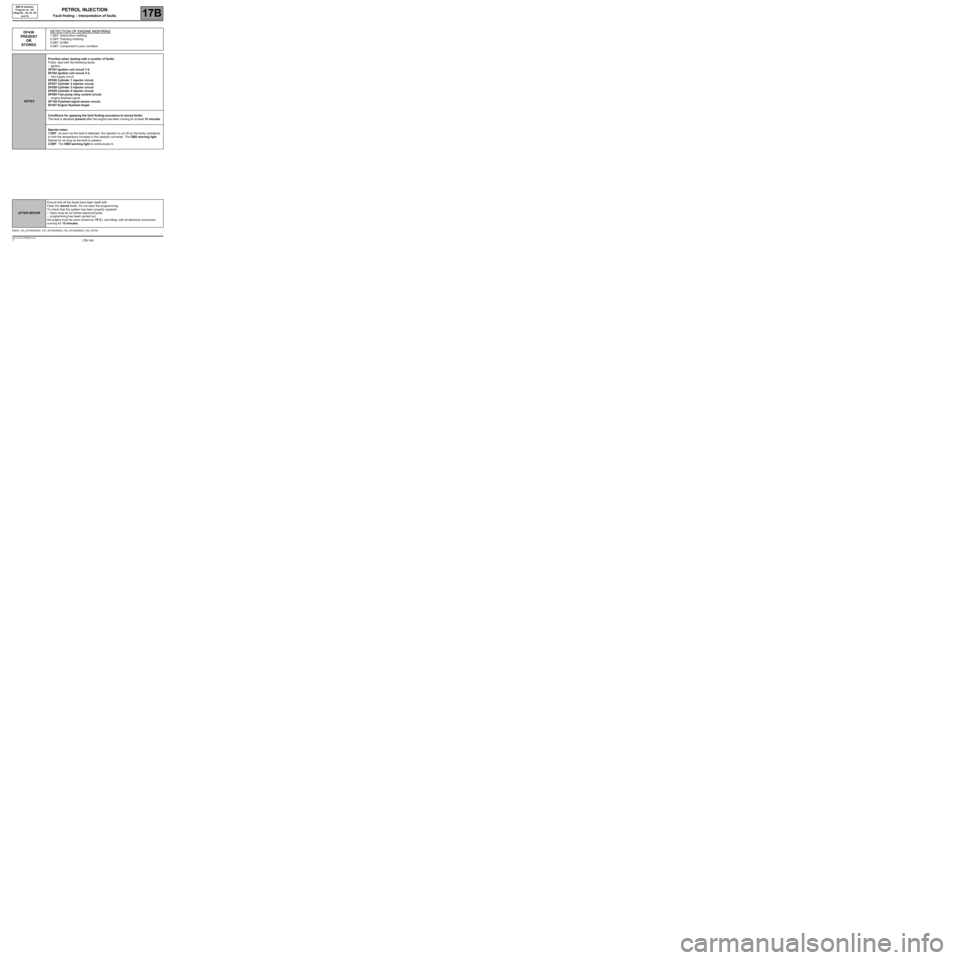
17B-146V7 MR-413-X44-17B000$133.mif
PETROL INJECTION
Fault finding – Interpretation of faults17B
SIM 32 Injection
Program no.: D3
Vdiag No.: 44, 4C, 50
and 54
DF436
PRESENT
OR
STOREDDETECTION OF ENGINE MISFIRING1.DEF: Destructive misfiring
2.DEF: Polluting misfiring
3.DEF: EOBD
4.DEF: Component in poor condition
NOTESPriorities when dealing with a number of faults:
Firstly, deal with the following faults:
–ignition
DF351 Ignition coil circuit 1-4,
DF352 Ignition coil circuit 2-3,
–fuel supply circuit
DF026 Cylinder 1 injector circuit
DF027 Cylinder 2 injector circuit,
DF028 Cylinder 3 injector circuit
DF029 Cylinder 4 injector circuit,
DF085 Fuel pump relay control circuit,
–engine flywheel signal
DF154 Flywheel signal sensor circuit,
DF457 Engine flywheel target.
Conditions for applying the fault finding procedure to stored faults:
The fault is declared present after the engine has been running for at least 15 minutes.
Special notes:
1.DEF: As soon as the fault is detected, the injection is cut off on the faulty cylinder(s)
to limit the temperature increase in the catalytic converter. The OBD warning light
flashes for as long as the fault is present.
2.DEF: The OBD warning light is continuously lit.
SIM32_V44_DF436/SIM32_V4C_DF436/SIM32_V50_DF436/SIM32_V54_DF436
AFTER REPAIREnsure that all the faults have been dealt with.
Clear the stored faults. Do not clear the programming.
To check that the system has been properly repaired:
–there must be no further electrical faults,
–programming has been carried out,
the engine must be warm (minimum 75˚C), and idling, with all electrical consumers
running for 15 minutes.
Page 150 of 348

17B-150V7 MR-413-X44-17B000$133.mif
PETROL INJECTION
Fault finding – Interpretation of faults17B
SIM 32 Injection
Program no.: D3
Vdiag No.: 44, 4C, 50
and 54
DF508
PRESENT
OR
STOREDMOTORISED THROTTLE VALVE CONTROL
1.DEF: Component in bad condition
2.DEF: EOBD
CC.1: Short circuit to 12 V
WARNING:
Never drive the vehicle without having confirmed that no faults involving the throttle valve are present.
NOTESPriorities when dealing with a number of faults:
If faults DF095 Throttle potentiometer circuit gang 1 and DF096 Throttle
potentiometer circuit gang 2 are present, deal with these first.
Conditions for applying the fault finding procedure to stored faults:
The fault is declared as present with the ignition on or the engine running, or during
command AC027 Motorised throttle.
Special notes:
In the event of faults, the level 1 warning light comes on, the injection goes into defect
mode 1 and 2, causing a limitation of vehicle and engine speed. The ESP and the cruise
control - speed limiter are deactivated.
Use the Wiring Diagrams Technical Note for NEW TWINGO, E33, CLIO III,
or MODUS.
Check the condition of the connector of the engine throttle valve (component code 120) and of the throttle valve
(component code 1076).
If the connector or connectors are faulty and if there is a repair procedure (see Technical Note 6015A, Repairing
electrical wiring, Wiring: Precautions for repair), repair the connector, otherwise replace the wiring.
SIM32_V44_DF508/SIM32_V4C_DF508/SIM32_V50_DF508/SIM32_V54_DF508
AFTER REPAIRIf the throttle valve has been replaced, program the throttle stops (see
Configurations and programming).
Follow the instructions to confirm repair:
–If the fault is present, continue to deal with the fault.
–If the fault is stored, ignore it.
Deal with any other faults.
Clear the stored faults.
Page 154 of 348
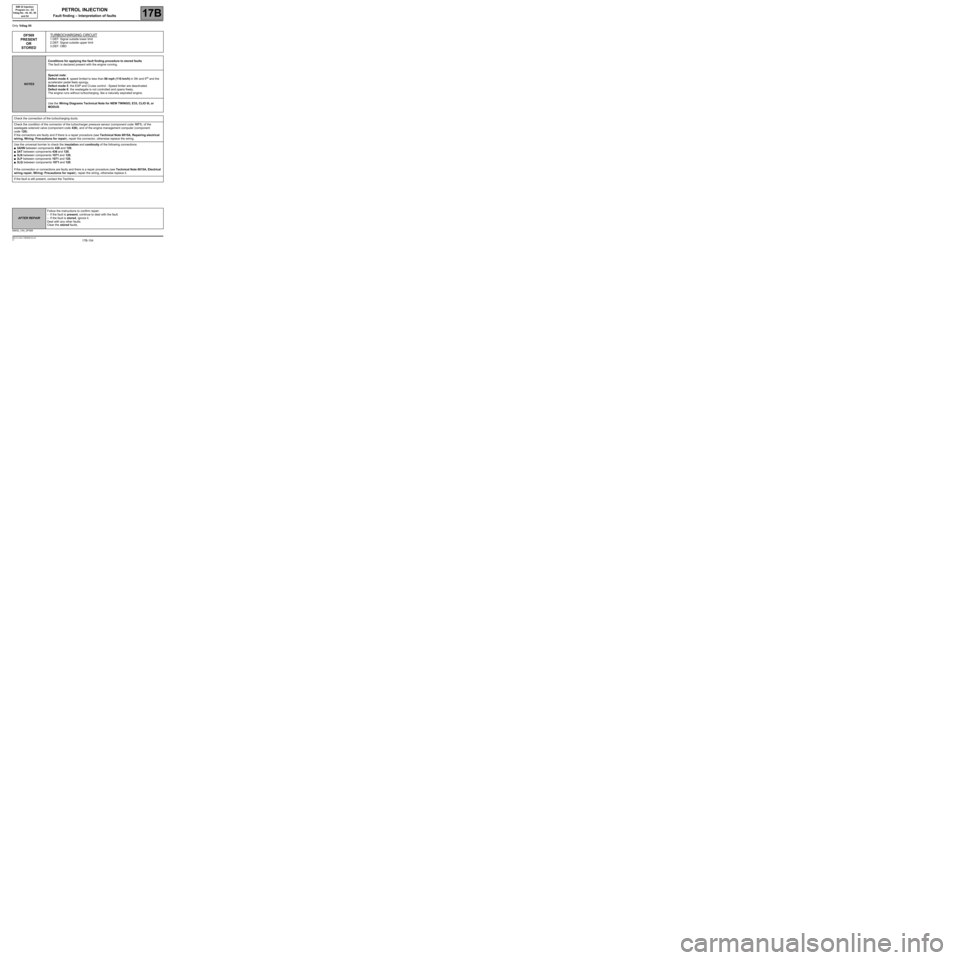
17B-154V7 MR-413-X44-17B000$133.mif
PETROL INJECTION
Fault finding – Interpretation of faults17B
SIM 32 Injection
Program no.: D3
Vdiag No.: 44, 4C, 50
and 54
Only Vdiag 54
DF569
PRESENT
OR
STOREDTURBOCHARGING CIRCUIT
1.DEF: Signal outside lower limit
2.DEF: Signal outside upper limit
3.DEF: OBD
NOTESConditions for applying the fault finding procedure to stored faults
The fault is declared present with the engine running.
Special note:
Defect mode 4: speed limited to less than 66 mph (110 km/h) in 5th and 6
th and the
accelerator pedal feels spongy.
Defect mode 5: the ESP and Cruise control - Speed limiter are deactivated.
Defect mode 6: the wastegate is not controlled and opens freely.
The engine runs without turbocharging, like a naturally aspirated engine.
Use the Wiring Diagrams Technical Note for NEW TWINGO, E33, CLIO III, or
MODUS.
Check the connection of the turbocharging ducts.
Check the condition of the connector of the turbocharger pressure sensor (component code 1071), of the
wastegate solenoid valve (component code 436), and of the engine management computer (component
code 120).
If the connectors are faulty and if there is a repair procedure (see Technical Note 6015A, Repairing electrical
wiring, Wiring: Precautions for repair), repair the connector, otherwise replace the wiring.
Use the universal bornier to check the insulation and continuity of the following connections:
●3AHN between components 436 and 120,
●3AT between components 436 and 120,
●3LN between components 1071 and 120,
●3LP between components 1071 and 120,
●3LQ between components 1071 and 120.
If the connection or connections are faulty and there is a repair procedure (see Technical Note 6015A, Electrical
wiring repair, Wiring: Precautions for repair), repair the wiring, otherwise replace it.
If the fault is still present, contact the Techline.
SIM32_V54_DF569
AFTER REPAIRFollow the instructions to confirm repair:
–If the fault is present, continue to deal with the fault.
–If the fault is stored, ignore it.
Deal with any other faults.
Clear the stored faults.
Page 160 of 348
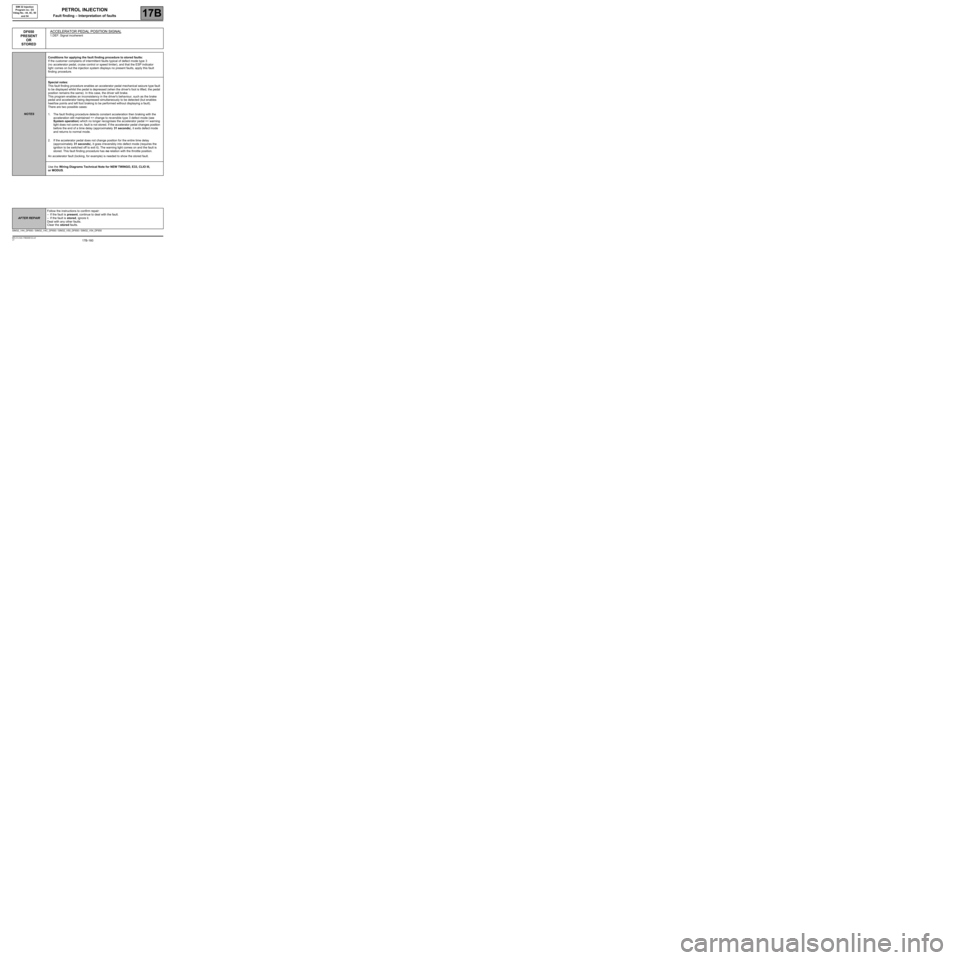
17B-160V7 MR-413-X44-17B000$133.mif
PETROL INJECTION
Fault finding – Interpretation of faults17B
SIM 32 Injection
Program no.: D3
Vdiag No.: 44, 4C, 50
and 54
DF650
PRESENT
OR
STOREDACCELERATOR PEDAL POSITION SIGNAL
1.DEF: Signal incoherent
NOTESConditions for applying the fault finding procedure to stored faults:
If the customer complains of intermittent faults typical of defect mode type 3
(no accelerator pedal, cruise control or speed limiter), and that the ESP indicator
light comes on but the injection system displays no present faults, apply this fault
finding procedure.
Special notes:
This fault finding procedure enables an accelerator pedal mechanical seizure type fault
to be displayed whilst the pedal is depressed (when the driver's foot is lifted, the pedal
position remains the same). In this case, the driver will brake.
This program enables an inconsistency in the driver's behaviour, such as the brake
pedal and accelerator being depressed simultaneously to be detected (but enables
heel/toe points and left foot braking to be performed without displaying a fault).
There are two possible cases:
1. The fault finding procedure detects constant acceleration then braking with the
acceleration still maintained => change to reversible type 3 defect mode (see
System operation) which no longer recognises the accelerator pedal => warning
light does not come on, fault is not stored. If the accelerator pedal changes position
before the end of a time delay (approximately 31 seconds), it exits defect mode
and returns to normal mode.
2. If the accelerator pedal does not change position for the entire time delay
(approximately 31 seconds), it goes irreversibly into defect mode (requires the
ignition to be switched off to exit it). The warning light comes on and the fault is
stored. This fault finding procedure has no relation with the throttle position.
An accelerator fault (locking, for example) is needed to show the stored fault.
Use the Wiring Diagrams Technical Note for NEW TWINGO, E33, CLIO III,
or MODUS.
SIM32_V44_DF650 / SIM32_V4C_DF650 / SIM32_V50_DF650 / SIM32_V54_DF650
AFTER REPAIRFollow the instructions to confirm repair:
–If the fault is present, continue to deal with the fault.
–If the fault is stored, ignore it.
Deal with any other faults.
Clear the stored faults.
Page 162 of 348
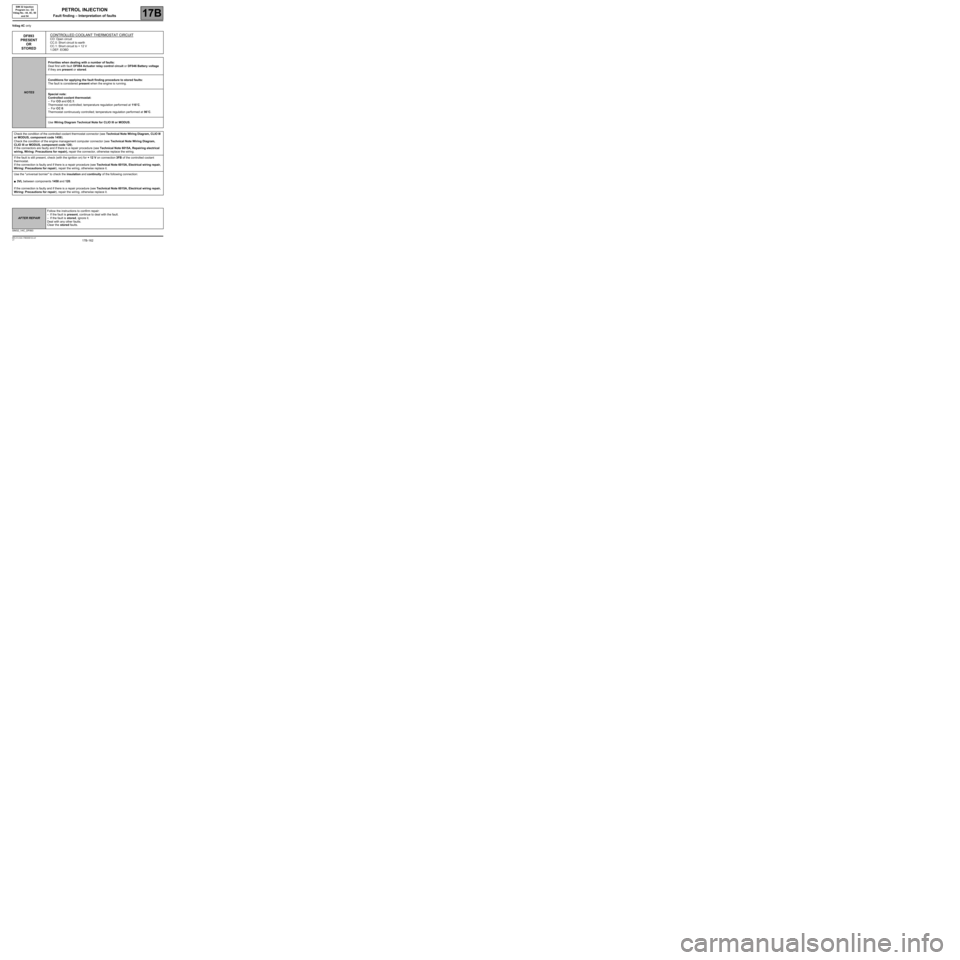
17B-162V7 MR-413-X44-17B000$133.mif
PETROL INJECTION
Fault finding – Interpretation of faults17B
SIM 32 Injection
Program no.: D3
Vdiag No.: 44, 4C, 50
and 54
Vdiag 4C only
DF893
PRESENT
OR
STOREDCONTROLLED COOLANT THERMOSTAT CIRCUITCO: Open circuit
CC.0: Short circuit to earth
CC.1: Short circuit to + 12 V
1.DEF: EOBD
NOTESPriorities when dealing with a number of faults:
Deal first with fault DF084 Actuator relay control circuit or DF046 Battery voltage
if they are present or stored.
Conditions for applying the fault finding procedure to stored faults:
The fault is considered present when the engine is running.
Special note:
Controlled coolant thermostat:
–For CO and CC.1:
Thermostat not controlled; temperature regulation performed at 110˚C.
–For CC 0:
Thermostat continuously controlled; temperature regulation performed at 90˚C.
Use Wiring Diagram Technical Note for CLIO III or MODUS.
Check the condition of the controlled coolant thermostat connector (see Technical Note Wiring Diagram, CLIO III
or MODUS, component code 1458).
Check the condition of the engine management computer connector (see Technical Note Wiring Diagram,
CLIO III or MODUS, component code 120).
If the connectors are faulty and if there is a repair procedure (see Technical Note 6015A, Repairing electrical
wiring, Wiring: Precautions for repair), repair the connector, otherwise replace the wiring.
If the fault is still present, check (with the ignition on) for + 12 V on connection 3FB of the controlled coolant
thermostat.
If the connection is faulty and if there is a repair procedure (see Technical Note 6015A, Electrical wiring repair,
Wiring: Precautions for repair), repair the wiring, otherwise replace it.
Use the "universal bornier" to check the insulation and continuity of the following connection:
●3VL between components 1458 and 120.
If the connection is faulty and if there is a repair procedure (see Technical Note 6015A, Electrical wiring repair,
Wiring: Precautions for repair), repair the wiring, otherwise replace it.
SIM32_V4C_DF893
AFTER REPAIRFollow the instructions to confirm repair:
–If the fault is present, continue to deal with the fault.
–If the fault is stored, ignore it.
Deal with any other faults.
Clear the stored faults.
Page 171 of 348
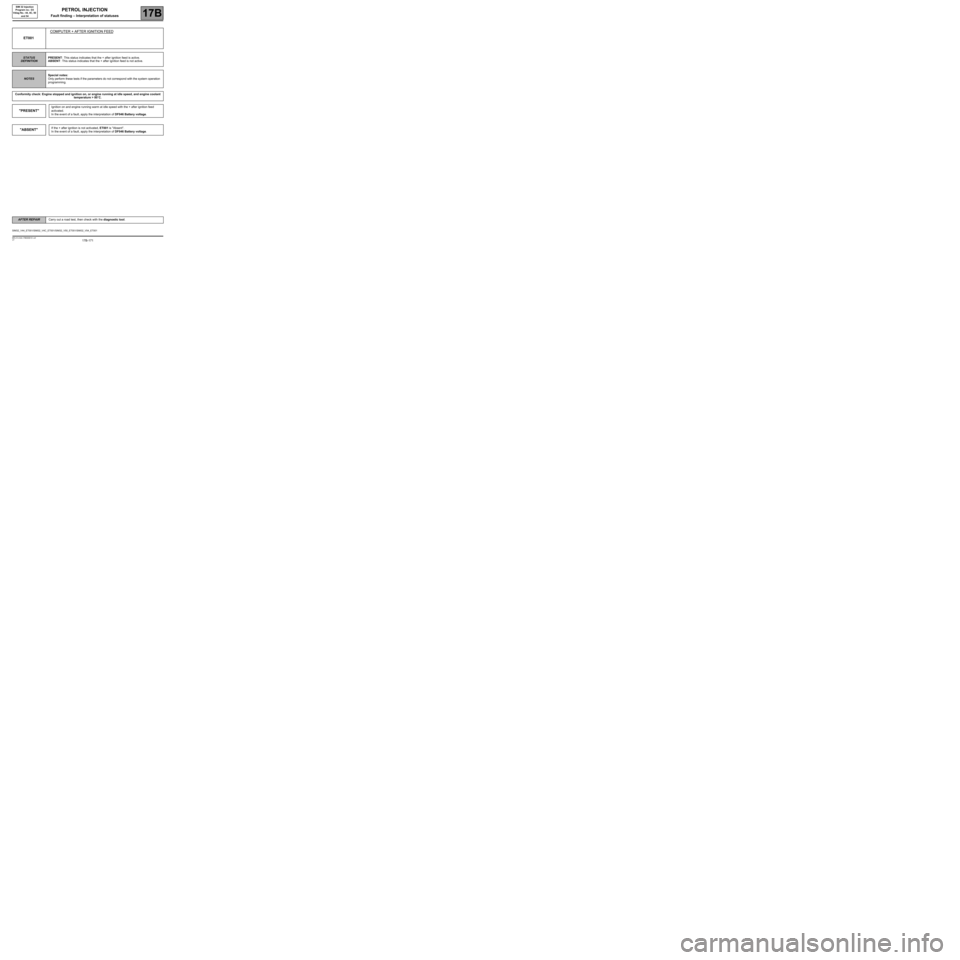
17B-171V7 MR-413-X44-17B000$151.mif
17B
SIM 32 Injection
Program no.: D3
Vdiag No.: 44, 4C, 50
and 54
ET001COMPUTER + AFTER IGNITION FEED
STATUS
DEFINITIONPRESENT: This status indicates that the + after ignition feed is active.
ABSENT: This status indicates that the + after ignition feed is not active.
NOTESSpecial notes:
Only perform these tests if the parameters do not correspond with the system operation
programming.
Conformity check: Engine stopped and ignition on, or engine running at idle speed, and engine coolant
temperature > 80˚C.
"PRESENT"
Ignition on and engine running warm at idle speed with the + after ignition feed
activated.
In the event of a fault, apply the interpretation of DF046 Battery voltage.
"ABSENT"If the + after ignition is not activated, ET001 is "Absent".
In the event of a fault, apply the interpretation of DF046 Battery voltage.
SIM32_V44_ET001/SIM32_V4C_ET001/SIM32_V50_ET001/SIM32_V54_ET001
AFTER REPAIRCarry out a road test, then check with the diagnostic tool.
PETROL INJECTION
Fault finding – Interpretation of statuses
Page 172 of 348

17B-172V7 MR-413-X44-17B000$151.mif
PETROL INJECTION
Fault finding – Interpretation of statuses17B
SIM 32 Injection
Program no.: D3
Vdiag No.: 44, 4C, 50
and 54
ET003ENGINE IMMOBILISER
STATUS
DEFINITIONACTIVE: This status indicates that the immobiliser is active.
INACTIVE: This status indicates that the immobiliser is inactive.
NOTESSpecial notes:
Only perform these tests if the parameters do not correspond with the system operation
programming.
Conformity check: Engine stopped and ignition on, or engine running at idle speed, and engine coolant
temperature > 80˚C.
"ACTIVE"Refer to the fault finding note for the UCH (see 87B, Passenger compartment
connection unit).
"INACTIVE"Refer to the fault finding note for the UCH (see 87B, Passenger compartment
connection unit).
SIM32_V44_ET003/SIM32_V4C_ET003/SIM32_V50_ET003/SIM32_V54_ET003
AFTER REPAIRCarry out a road test, then check with the diagnostic tool.
Page 173 of 348
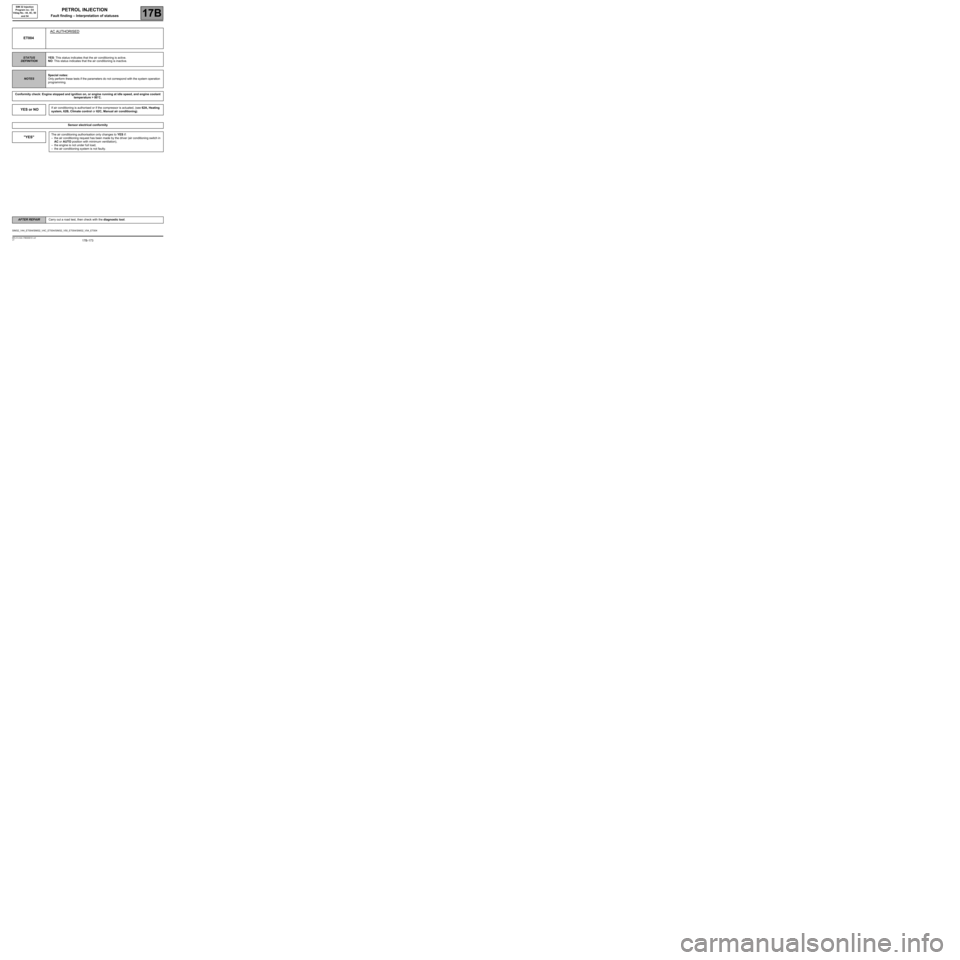
17B-173V7 MR-413-X44-17B000$151.mif
PETROL INJECTION
Fault finding – Interpretation of statuses17B
SIM 32 Injection
Program no.: D3
Vdiag No.: 44, 4C, 50
and 54
ET004AC AUTHORISED
STATUS
DEFINITIONYES: This status indicates that the air conditioning is active.
NO: This status indicates that the air conditioning is inactive.
NOTESSpecial notes:
Only perform these tests if the parameters do not correspond with the system operation
programming.
Conformity check: Engine stopped and ignition on, or engine running at idle speed, and engine coolant
temperature > 80˚C.
YES or NOIf air conditioning is authorised or if the compressor is actuated, (see 62A, Heating
system, 62B, Climate control or 62C, Manual air conditioning).
Sensor electrical conformity
"YES"The air conditioning authorisation only changes to YES if:
–the air conditioning request has been made by the driver (air conditioning switch in
AC or AUTO position with minimum ventilation),
–the engine is not under full load,
–the air conditioning system is not faulty.
SIM32_V44_ET004/SIM32_V4C_ET004/SIM32_V50_ET004/SIM32_V54_ET004
AFTER REPAIRCarry out a road test, then check with the diagnostic tool.